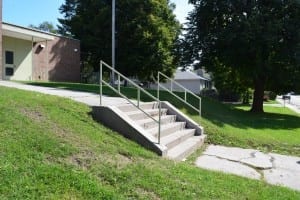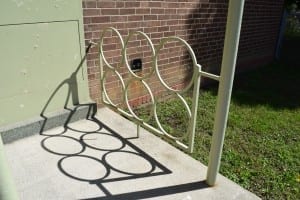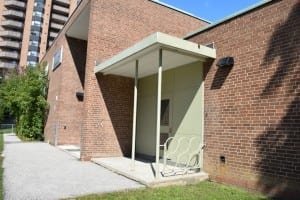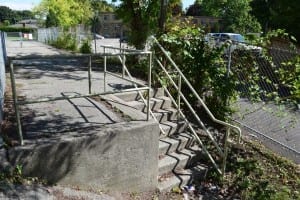
The image is from The Death of Drawing (2014), p. 170. The caption reads: “FIGURE 5.2. A typical suburban tract house: an image with no referent, i.e. simulacrum. Source: BrendelSignature/CC BY-SA 3.0” COMMENT: I am keen to find out what the captions means. Among the questions that arise is: How does a person define ‘suburban tract house’?
Architectural drawing represents ideas in form. Building information modelling (BIM) simulates experience.
A blurb for The Death of Drawing: Architecture in the Age of Simulations (2014) distinguishes between architectural drawing and building information modelling (BIM).
Drawing, the blurb notes, which “allowed architects to represent ideas in form,” has been displaced by computations as “the chief design and communication medium in architecture.”
According to the blurb, “whereas drawing allowed architects to represent ideas in form, BIM and computational design simulate experience, making building behavior or performance the primary object of design.”

Parkview School: Detail. The school was designed in the 1950s by a Long Branch architect, Gresley Elton Jaan Pill photo
The purpose of the present blog post is to highlight books that address themes related to the distinction, between representation and simulation, as outlined in The Death of Drawing (2014).
I am keen to explore the distinction between representation and simulation, before I read the above-noted study.
That is, before I read The Death of Drawing (2014) in depth, I will seek to first ask some questions.
I seek to understand the story at a visual level, on my own, prior to seeking to figure out how the book addresses the topics at hand.
By way of language usage, I will seek to get a sense of what it means when a person says that an image (e.g. of what is described as a suburban tract house on p. 170 of The Death of Drawing (2014) ) has no referent.
An online Mirriam-Webster definition notes that ‘referent’ can be defined as: one that refers or is referred to; especially: the thing that a symbol (as a word or sign) stands for.
A secondary interest that I have is to determine to what extent such language serves to obfuscate, and clarify.
The question of what qualifies as ‘suburban tract house’ also interests me. Is the term used in a pejorative sense on p. 170 of the above-noted book?
The topic is of interest to me, because new houses, with appearances somewhat similar to the design on p. 170, especially if clad in stone, are highly appealing to at least one 15-year-old respondent that I have spoken with, at length, regarding architectural design. The appeal of a particular design, according to the respondent, is not based on a generalized view about the style of design, but is determined instead on a case-by-case basis. You look at the house, and you determine at once whether the design works or not.
Under such conditions, I ask myself by way of a preliminary analysis, who cares about 1) whether to not we are dealing, or not dealing, with a simulacrum and 2) whether or not there is or is not a referent in the picture?
Gresley Elton was a Long Branch architect during the era before computational design
At a May 5, 2013 Jane’s Walk, we learned that Gresley Elton was the architect who designed Parkview School at 85 Forty First Street in Long Branch (Toronto not New Jersey). We learned about some architectural details – as seen in the photos at this page – that are characteristic of Elton’s work. In studying the details, I have often thought about the fact that architectural designs based on drawings at a drawing board appear – at least to my mind – to have characteristics, having to do with form and proportion – that distinguish them from computational design. It was this fact that gave rise to my interest in The Death of Drawing (2014).
Gresley Elton’s architectural design, including the details such as railings and posts, are characterized by a sense of composition – by way of the arrangement and proportions of the constituent elements – that I find very pleasing. There’s a sense of “rightness,” and of harmony and repose, that I find appealing in his work.
Occasionally I come across structures, that were likely prepared though computational design, that have similar qualities of composition, evoking similar responses that can be characterized as giving arise to a sense that some thought and care has gone into the design. In other cases, such qualities appear lacking.
Drawing displaced by building information modeling (BIM)
In the past, a blurb for The Death if Drawing (2014) notes, drawing “framed the thinking of architects and organized the design and construction process to place architects at its center.”
Now, building information modeling (BIM) and computational design has come to the fore, giving rise in turn to change in “the terms in which architects think and their role in building production.”
Representation of ideas in form has given way to the simulation of experience, according to The Death of Drawing
A central argument, advanced in the blurb, is that drawing focuses upon the representation of ideas in form, whereas building information modeling and computational design focuses upon the simulation of experience.

Railings, designed by Long Branch architect Gresley Elton, at steps at Parkview School. Jaan Pill photo
What do the above-noted terms, highlighted in bold text, mean? That is a primary question that comes to mind, as I prepare to read the book, sometime in the next year or two.
Suggested reading
Also of relevance, by way of organizing my small reading project, are the following studies:
This Virtual Life (2001)
1) This Virtual Life (2001). A blurb notes: “As the media becomes more sophisticated and lifelike, we spend more and more time in front of television screens. Distinguished psychologist Andrew Evans examines this warping of reality, and asks where such a path will lead us.”
Simulation and Its Discontents (2009)
2) Simulation and Its Discontents (2009). A blurb notes: “Over the past twenty years, the technologies of simulation and visualization have changed our ways of looking at the world. In Simulation and Its Discontents, Sherry Turkle examines the now dominant medium of our working lives and finds that simulation has become its own sensibility. We hear it in Turkle’s description of architecture students who no longer design with a pencil, of science and engineering students who admit that computer models seem more ‘real’ than experiments in physical laboratories.”
Science in the Age of Computer Simulation (2010)
3) Science in the Age of Computer Simulation (2010). A blurb notes: “Computer simulation was first pioneered as a scientific tool in meteorology and nuclear physics in the period following World War II, but it has grown rapidly to become indispensible in a wide variety of scientific disciplines, including astrophysics, high-energy physics, climate science, engineering, ecology, and economics. Digital computer simulation helps study phenomena of great complexity, but how much do we know about the limits and possibilities of this new scientific practice? How do simulations compare to traditional experiments? And are they reliable? Eric Winsberg seeks to answer these questions in Science in the Age of Computer Simulation.”
Reclaiming Canadian Bodies: Representation and Visual Media (2015)
4) Reclaiming Canadian Bodies: Representation and Visual Media (2015). A blurb notes: “Drawing upon rich empirical research and relevant theory, the contributors ask how and why particular bodies (of Estonian immigrants, sports stars, First Nations peoples, self-identified homosexuals, and women) are either promoted and upheld as ‘Canadian’ bodies while others are marginalized in or excluded from media representations.”
Things and Places: How the Mind Connects with the World (2007)
5) Things and Places: How the Mind Connects with the World (2007). A blurb notes: “In Things and Places, Zenon Pylyshyn argues that the process of incrementally constructing perceptual representations, solving the binding problem (determining which properties go together), and, more generally, grounding perceptual representations in experience arise from the nonconceptual capacity to pick out and keep track of a small number of sensory individuals. He proposes a mechanism in early vision that allows us to select a limited number of sensory objects, to reidentify each of them under certain conditions as the same individual seen before, and to keep track of their enduring individuality despite radical changes in their properties – all without the machinery of concepts, identity, and tenses.”
Visual Art and Education in an Era of Designer Capitalism: Deconstructing the Oral Eye (2010)
6) Visual Art and Education in an Era of Designer Capitalism: Deconstructing the Oral Eye (2010). A blurb notes: “The oral eye is a metaphor for the dominance of global designer capitalism. It refers to the consumerism of a designer aesthetic by the ‘I’ of the neoliberalist subject, as well as the aural soundscapes that accompany the hegemony of the capturing attention through screen cultures.”
The Doodle Revolution: Unlock the Power to Think Differently (2014)
7) The Doodle Revolution: Unlock the Power to Think Differently (2014). A blurb notes: “The instinctive and universal act of doodling need only be unleashed in order to innovate, solve problems, and elevate cognitive performance instantly. With humor, wit, and a commitment to disrupting our perceptions of doodling, Brown teaches us how to: Doodle any object, concept, or system imaginable. Invent, innovate, and solve messy problems. Transform text into a visual display that engages an audience. Explain the relevance of visual literacy to leaders at work and at school. Despite what our culture suggests, doodling and sketching are powerful tools and they are for everyone, not just artsy types. It’s time we recognize visual literacy as a fundamental requirement for the future.”
Photography, Memory, and Refugee Identity: The Voyage of the SS Walnut, 1948 (2013)
8) Photography, Memory, and Refugee Identity: The Voyage of the SS Walnut, 1948 (2013). A blurb notes: “In 1948, a small ship carrying Estonian refugees arrived at Pier 21 in Halifax. In this absorbing work, anthropologist Lynda Mannik analyzes the refugee experience through the photographic record of those who made that harrowing voyage. Drawing on a collection of photographs taken during the voyage and at Pier 21, Mannik asks surviving passengers to describe their journey, their reception in Canada, and to what extent the photos reflect their experiences as they remember them. The photographs in the SS Walnut collection, she argues, bear witness to the refugee experience even as the meanings attached to them have changed over time and in shifting contexts.”
Navajo and Photography: A Critical History of the Representation of an American People (1996)
9) Navajo and Photography: A Critical History of the Representation of an American People (1996). A blurb notes: “[James C.] Faris (professor emeritus, anthropology, U. of Connecticut) surveys the assumptions that have governed photographic representations of Navajo people by white Westerners, from the earliest photographs of Navajo in captivity at the Bosque Redondo to the most recent glossy picture books and calendars.”
Simulacra and Simulation (1995)
10) Simulacra and Simulation (1995). The blurb notes: “Develops a theory of contemporary culture that relies on displacing economic notions of cultural production with notions of cultural expenditure. This book represents an effort to rethink cultural theory from the perspective of a concept of cultural materialism, one that radically redefines postmodern formulations of the body.”
The Rebel Sell: Why the Culture Can’t be Jammed (2004)
11) The Rebel Sell: Why the Culture Can’t be Jammed (2004). An online review notes: “The Rebel Sell is a brave book. In places it is also unfair, light on evidence and repetitively polemical. But the argument it makes is important and original. Joseph Heath and Andrew Potter, both young Canadian academics, think that for nearly half a century critics of capitalism have profoundly misunderstood their enemy. Worse than that, the authors argue, these critics have – sometimes unintentionally, sometimes not – provided modern capitalism with the fuel it runs on.”
The Image Factory: Consumer Culture, Photography and the Visual Content Industry (2003)
12) The Image Factory: Consumer Culture, Photography and the Visual Content Industry (2003). A blurb notes: “Quietly but implacably, powerful transnational corporations are gaining power over our visual world. A ‘global, visual content industry’ increasingly controls images supplied to advertisers, marketers and designers, yet so far the process has, paradoxically, evaded the public eye.”
Punk: Chaos to Couture (2013)
13) Punk: Chaos to Couture (2013). An online review notes: “With ‘Punk,’ Andrew Bolton, curator of the Costume Institute and organizer of ‘Schiaparelli and Prada,’ presents his ideas in a clear, orderly manner. This clarity sometimes simplifies things, giving punk credit for innovations that were already in the subcultural air in the 1960s and early ’70s. For example, hippies, whom the punks disdained, customized their Army-Navy surplus clothes and also used T-shirts for political statements. With around 60 of the show’s 95 ensembles dating from 2006 or later, the recent signs of punk’s influence are much more prominent than its history. If that history were the point, a 1981 or ’82 Comme des Garçons black, punk-inspired sweater dress, with conspicuous holes, would be displayed instead of a similar Calvin Klein design from 2007.”
Pop Art and Vernacular Cultures (2007)
14) Pop Art and Vernacular Cultures (2007). A blurb notes: “How does pop art translate across cultures? What does pop art look like through a postcolonial lens? In the global marketplace of images, artists have long challenged the discourse of officialdom by turning to dissident elements in the languages of vernacular culture. This volume casts new light on the aesthetics and politics of pop by taking a cross-cultural perspective on what happens when everyday objects are taken out of one context and repositioned in the language of art.”
A Carpenter’s Life as Told by Houses (2011)
15) A Carpenter’s Life as Told by Houses (2011). A blurb notes: “From one of Fine Homebuilding’s best-loved authors, Larry Haun, comes a unique story that looks at American home building from the perspective of twelve houses he has known intimately. Part memoir, part cultural history, A Carpenter’s Life as Told by Houses takes the reader house by house over an arc of 100 years.”
Masters of the Universe: Hayek, Friedman, and the Birth of Neoliberal Politics (2012)
16) Masters of the Universe: Hayek, Friedman, and the Birth of Neoliberal Politics (2012). A blurb notes: “How did American and British policymakers become so enamored with free markets, deregulation, and limited government? This book – the first comprehensive transatlantic history of the rise of neoliberal politics – presents a surprising answer. Based on archival research and interviews with leading participants in the movement, Masters of the Universe traces the ascendancy of neoliberalism from the academy of interwar Europe to supremacy under Reagan and Thatcher and in the decades since. Daniel Stedman Jones argues that there was nothing inevitable about the victory of free-market politics. Far from being the story of the simple triumph of right-wing ideas, the neoliberal breakthrough was contingent on the economic crises of the 1970s and the acceptance of the need for new policies by the political left.”
Reviews of Masters of the Universe (2012)
1) A Los Angeles Times review of the book can be accessed here.
The latter review concludes: “We may very well conclude not that free market ideology has coopted the left, but that resistance to actually existing capitalism now takes a form inassimilable to the political positions of the early postwar period. Perhaps Jane Jacobs is different from Milton Friedman after all. Perhaps there are two visions of the free market, left and right, and we will one day look back on the postwar period as the emergence of a new form of ideological struggle. For now, the scale of the problem is visible only in the distortions it causes in so sober a history as this one.”
2) A review of the above-noted book at the London School of Economics website can be accessed here.
3) A review at The Economistt website can be accessed here.
The review notes: “Thus was neoliberalism founded. One hitch with writing about it is that the word is frequently misused today. Leftists use “neoliberal” to describe people whom they essentially do not like. Mr Stedman Jones seems to think the word should not be ditched; the original pugilists against state control happily went by that name.”
The review concludes: ” “Masters of the Universe” is a little thin on character sketches and economics. But it is a strong work. Mr Stedman Jones offers a novel and comprehensive history of neoliberalism. It is tarred neither by a reverence for the heroes, nor by caricature, for he is a fair and nuanced writer. This is a bold biography of a great idea.”
Rethinking Money (2013)
17) Rethinking Money: How New Currencies Turn Scarcity into Prosperity (2013). A blurb for the book, which I learned of through a CBC The Current article, notes: “Many of the world’s economic ills – short-termism, compulsory growth pressure, cyclical recessions, unrelenting concentration of wealth, and erosion of social capital – can be traced to our competitive money system, in which there is built-in economic scarcity and never enough money for people to pay off their debts. We need an economic system that is both cooperative and competitive, with each balancing and [complementing] the other. Lietaer and Dunne tell how such a balanced system can be created and, in fact, how it is already being built in many places around the world. Individual citizens, entrepreneurs, businesses, communities, and governments are creating new cooperative money systems that link unused resources with unmet needs. Over the past 30 years there has been a tremendous growth of cooperative currencies – from fewer than 100 in 1980 to over 4,000 today. But we need many more of them spread more consistently all over the globe. We also need more large-scale cooperative currencies. The emergent cooperative currency movement needs to grow up. Dodging the dogma of both left or right Rethinking Money provides the roadmap for this to happen.”
The Housing Bomb (2013)
18) The Housing Bomb: Why Our Addiction to Houses is Destroying the Environment and Threatening Our Society (2013). A blurb for The Housing Bomb, which I have discussed in a previous post, notes: “Presenting irrefutable evidence, this book cries out for America and the world to intervene by making simple changes in our household energy and water usage and by supporting municipal, state, national, and international policies to counter this devastation and overuse of resources. It offers a way out of the mess we are creating and envisions a future where we all live comfortable, nondestructive lives. The “housing bomb” is ticking, and our choice is clear – change our approach or feel the blast.”
19) Out of Our Heads: Why You Are Not Your Brain, and Other Lessons from the Biology of Consciousness (2009). A blurb notes: “Alva Noë is one of a new breed—part philosopher, part cognitive scientist, part neuroscientist—who are radically altering the study of consciousness by asking difficult questions and pointing out obvious flaws in the current science. In Out of Our Heads, he restates and reexamines the problem of consciousness, and then proposes a startling solution: Do away with the two hundred-year-old paradigm that places consciousness within the confines of the brain.”
Authenticity, yours and mine
A concept that is related to language usage, as it relates to representation and simulation, is the concept of authenticity, which has been addressed in previous posts including:
“The Problem With Authenticity” – February 2015 Harvard Business Review
Entry points for analysis of The Death of Drawing (2014)
My aim in studying this book is modest. I seek to understand how representation and simulation are addressed in The Death of Drawing (2014), as contrasted to similar or differing uses of the terms in a range of other selected contexts.
Updates:
A useful and practical overview highlighting topics addressed at this post is entitled: The End of Alchemy: Money, Banking and the Future of the Global Economy (2016).
An Aug. 17, 2019 ArchDaily article is entitled: “How Renderings Can Contribute to Architectural Projects: The Lumion Example.”
A Dec. 4, 2019 Dezeen article is entitled: “”We banned renders” from the design process says Tatiana Bilbao.”
An excerpt (I have omitted the embedded links) reads:
Mexican architect Tatiana Bilbao refuses to produce computer visualisations of designs still in progress. She says that making collages helps her to develop more exciting buildings.
Bilbao’s work is currently on show at the Louisiana Museum in Denmark. The exhibition doesn’t contain any computer renderings; instead designs for projects such as Casa Ajijic and Vivienda Popular are shown through models, sketches and collages.
The architect doesn’t like finalised images as they can become obstacles in the creative process. She prefers collage as she believes it fosters a more collaborative approach to design.
Seeing Like a State (1998)
In Seeing Like a State, James C. Scott addresses the impact of a bird’s eye (aerial) view of large-scale building projects, with reference to the history of ‘high modernist’ urban design.
Click here for previous posts about Seeing Like a State (1998) by James C. Scott>






Leave a Reply
Want to join the discussion?Feel free to contribute!